

When used in the plural form, genres are the various categories of subject matter in the traditional academic hierarchy, in descending order of importance: history, megalography, mythology, religion, portraiture, genre (see the first sense above), landscape, still life, rhopography, and vernacular.
(pr. jahn're)
Examples of genre painting:

Greece, Figurine of Aphrodite Playing with Eros,
tanagra, late 4th century
BCE,
polychromed terra
cotta, height 18.5 cm,
State Hermitage Museum, St. Petersburg, Russia. This sculpture
of Aphrodite is amusing Eros with a spinning top illustrates
a tendency towards genre sculpture which was characteristic of
Hellenistic art. See mythology.

Petrus Christus (Flemish, Bruges, active
by 1444 - 1475/76), A Goldsmith in His Shop, Possibly Saint Eligius,
1449, oil on wood
panel, 38 5/8 x 33 1/2 inches (98
x 85.2 cm), Metropolitan Museum of Art, NY.
Quentin Metsys (Dutch, 1465/6-1530), The Banker and his Wife, 1514, oil on wood panel, 0.705 x 0.670 m, Louvre. See Dutch art and narrative art.
Pieter Brueghel the Elder (Flemish, 1525/30-1569), Peasant Wedding, c. 1568/69, oil on wood panel, 114 x 164 cm, Kunsthistoriches, Vienna.
Peter Paul Rubens (Flemish, 1577-1640), The Village Fete, c. 1635-1638, oil on wood panel, 1.49 x 2.61 m, Louvre.

Frans Hals (Dutch, c. 1581-1666), Young Man and Woman in an Inn ("Yonker Ramp
and His Sweetheart"), 1623, oil
on canvas, 41 1/2 x 31
1/4 inches (105.4 x 79.4 cm), Metropolitan Museum of Art, NY.
(On the Met's page, you can enlarge any detail.)

Hendrick Terbrugghen (Dutch, 1588-1629),
The Gamblers, 1623, oil
on canvas, 33 x 44 7/8
inches, Minneapolis Institute of Arts.

(Attributed to) Dirck Hals (Dutch, 1591-1656),
The Jovial Company, c. 1630,
oil on canvas,
32 inches x 39 1/2 inches (81.28 cm x 100.33 cm), Frick Collection, NY.

Jacob Jordaens (Flemish, 1593-1678), The Bean King, c. 1638, oil
on canvas (transferred
from old canvas), 62 x 83 inches (160 x 213 cm), Hermitage Museum,
St. Petersburg, Russia.

Diego
Velázquez (Diego Rodríguez de Silva y Velázquez)
(Spanish, 1599-1660), The
Family of Philip IV, or "The Maids of Honor (Las Meninas)", c. 1656, oil
on canvas, (318 x 276 cm),
Prado Museum, Madrid.
Here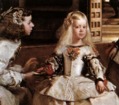 is a group portrait
(and self-portrait
too) that satisfies the requirements of a genre painting as well.
is a group portrait
(and self-portrait
too) that satisfies the requirements of a genre painting as well.
In the center-foreground
is the infanta (princess) attended by her meninas (maids of honor)
— companions
 including
two young ladies, a dwarf, a child, a dog, a nun, and a tutor.
including
two young ladies, a dwarf, a child, a dog, a nun, and a tutor.
This little party is visiting the studio
where Velázquez stands before his canvas. We see the back of it, perched upon
an easel. The painter and most
 of the others look
toward the king and queen as they pose for the painting in progress.
of the others look
toward the king and queen as they pose for the painting in progress.
The king and queen would not actually be
visible in this picture if their reflected
image could not be seen in a mirror
placed on the opposite wall. Altogether this is a view, which
could only be seen by the king and queen themselves, as
 they pose for their
portrait. The point of view
of every person who gazes
upon this painting is that of the king and queen of Spain. A
very privileged vantage indeed!
they pose for their
portrait. The point of view
of every person who gazes
upon this painting is that of the king and queen of Spain. A
very privileged vantage indeed!
Further
increasing the sense that we are present at a specific moment
is our glimpse of a man in the distant doorway, pausing as he
descends or ascends — either entering or exiting the chamber.
See Baroque and Spanish art.
Judith Leyster, (Dutch, 1609-1660), The Concert, c. 1633, oil on canvas, 24 x 34 1/4 inches, National Museum of Women in the Arts, Washington, DC.
David Teniers, the Younger (Flemish, 1610-1690), The Prodigal Son, c. 1650-1700, oil on canvas, Minneapolis Institute of Arts.

Adriaen van Ostade (Dutch, 1610-1684), Reading the News at the Weavers' Cottage,
1673, pen and brown ink,
watercolor, white heightening,
traces of graphite; framing
lines by the artist (?) in brown ink
and gold, 9 5/8
x 7 15/16 inches (24.4 x 20.2 cm), Metropolitan Museum of Art,
NY.
Adriaen van Ostade.

Jan Steen (Dutch, 1626-1679), The Idlers, c. 1660, oil
on panel, 15 x 12 inches (39 x
30 cm), Hermitage Museum, St. Petersburg, Russia.
Hooch, Pieter de (Dutch, 1629-1684).
Nicolaes Maes (Dutch, 1634-1693).
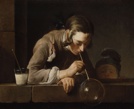
Jean-Baptiste Siméon Chardin (French,
1699-1779), Soap Bubbles, after 1739, oil
on canvas, 23 5/8 x 28
3/4 inches (60 x 73 cm), Los Angeles County Museum of Art.

Francisco Goya (Spanish, 1746-1828), The
Forge, between c. 1815 and 1820, oil
on canvas, 71 1/2 x 49
1/4 inches (181.6 x 125.1 cm), Frick Collection, NY.

Francis W. Edmonds (American, 1806-1863),
The New Bonnet, 1858, oil
on canvas, 25 x 30 1/8
inches (63.5 x 76.5 cm), Metropolitan Museum of Art, NY.

William Sidney Mount (American, 1807-1868),
Cider Making, 1840-1841, oil
on canvas, 27 x 34 1/8
inches (68.6 x 86.7 cm), Metropolitan Museum of Art, NY.
George Caleb Bingham (American, 1811-1879), Country Politician, 1849, oil on canvas, 20 3/8 x 24 inches (50.8 x 61 cm), Fine Arts Museums of San Francisco, CA.
Eastman Johnson (American, 1824-1906), The Brown Family, 1869, oil on canvas, 38 1/2 x 32 3/8 inches (82.5 x 98 cm), Fine Arts Museums of San Francisco, CA.

Eastman Johnson, The Hatch Family, 1870-1871, oil
on canvas, 48 x 73 3/8
inches (121.9 x 186.4 cm), Metropolitan Museum of Art, NY.
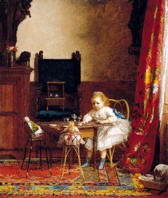
Eastman Johnson, The Tea Party, 1873, oil on panel, Phoenix Art Museum, AZ.
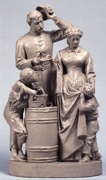
John Rogers (American, 1829-1904), Taking the Oath and Drawing Rations,
1866, cast and painted plaster,
Hood Museum of Art, Dartmouth College, NH.

Winslow Homer (American, 1836-1910), Sparrow Hall, c. 1881-1882, oil on canvas, collection of John Wilmerding. While visiting the fishing village of Cullercoats in the north of England, Homer painted these women and children enjoyed the sunshine at the doorways of their rustic, old house.

Pierre-Auguste Renoir (French, 1841-1919), The Luncheon of the Boating Party (Le déjeuner des canotiers), 1881, oil on canvas, 51 x 68 inches (129.5 x 172.7 cm), Phillips Collection, Washington, DC. The Collection offers The Story Behind the Masterpiece. See fête galante and Impressionism.

Sir Luke Fildes (English, 1843-1927), The Doctor, 1891, oil
on canvas, 166.4 x 241.9
cm, Tate Gallery, London. The Doctor was inspired by the
memory of the death of the painter's son fourteen years earlier,
and by the professional devotion of Dr. Gustavus Murray (1831-1887)
who attended the child. Fildes gave his painting a happier ending.
It shows the moment when, as dawn breaks, the patient shows the
first sign of recovery.

Mihály de Munkácsy (Hungarian,
1844-1900), The Music Room, 1878, oil
on canvas, 35 x 46 inches
(88.9 x 116.8 cm), Metropolitan Museum of Art, NY. See Hungarian art.

Thomas Dewing (American, 1851-1934), The Gossip, about 1907, oil
on panel, 12 x 16 3/8 inches, Minneapolis
Institute of Arts. See Ten American
Painters.

Julius L. Stewart (American, 1855-1919,
active in France), The Baptism, 1892, oil
on canvas, 79 1/4 x 118
1/4 inches (201.3 x 300.3 cm), Los Angeles County Museum of Art.

Frederic Remington (American, 1861-1909), Shotgun Hospitality,
1908, oil on canvas, Hood Museum of Art, Dartmouth College, NH. See nocturne.

George Wesley Bellows, (American, 1882-1925),
Cliff Dwellers, 1913, oil
on canvas, 40 1/8 x 42
inches (101.9 x 106.7 cm), Los Angeles County Museum of Art.
Also see Ashcan school.
Thomas Hart Benton (American, 1889-1975), Poker Night (from A Streetcar Named Desire), 1948, tempera and oil on panel, 36 x 48 inches, (91.4 x 121.9 cm), Whitney Museum of American Art, NY. See American Scene painting.
Norman Rockwell (American, 1894-1978), The County Agricultural Agent, c.1948, oil on canvas, 36 1/4 x 70 inches, Sheldon Memorial Art Gallery and Sculpture Garden, U of Nebraska, Lincoln.
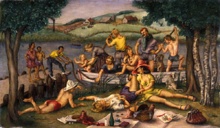
Ilse Martha Bischoff (American, 1901-1990), Picnic on the River,
1937, tempera on canvas laid on masonite, Hood Museum of Art, Dartmouth College, NH.
Paul Cadmus (American, 1904-1999), Sailors and Floosies, 1938, oil and tempera on panel, 25 x 39 1/2 inches (63.5 x 100.3 cm), Whitney Museum of American Art, NY. See frame.
Also see narrative art.
https://inform.quest/_art